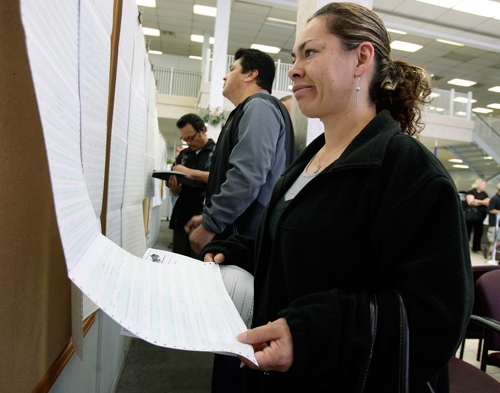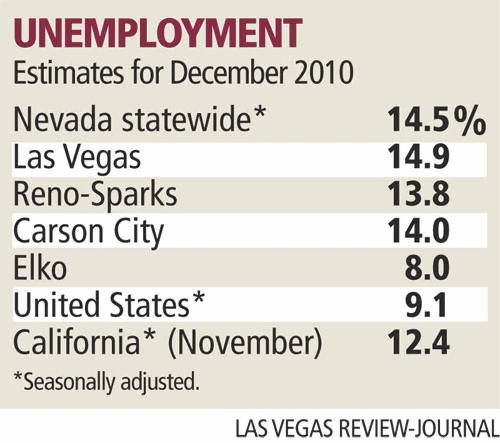Las Vegas unemployment rate climbs to record 14.9 percent
OK, so Nevada's job markets ended on an especially sour note in December, reaching 14.5 percent unemployment statewide and a record 14.9 percent in Las Vegas.
But several observers said Friday that the worst of the jobless gains have passed, and 2011 will bring at least a little relief, particularly in the hospitality sector that drives the rest of Nevada's economy.
To understand where joblessness will head through 2011, consider both job growth and the size of the state's work force.
On the job-creation front, experts said Nevada will likely see little to celebrate in the coming 12 months.
The Silver State's job formation averaged 6 percent a year in better times, noted Bill Anderson, chief economist of the state's Department of Employment, Training and Rehabilitation, which released Friday's jobless figures.
In 2011, though, the state's job markets will "barely eke out some gains" of maybe 1 percent, Anderson said.
That number could be optimistic if you weigh other analyses.
Stephen Brown, director of the Center for Business and Economic Research at the University of Nevada, Las Vegas, said his 2011 forecast calls for job growth of 0.4 percent. Jeremy Aguero, a principal of local research and consulting firm Applied Analysis, said his firm's outlook ranges from 1.5 percent growth under the best circumstances to a 2 percent contraction in the worst-case scenario. Job creation will likely average 0.5 percent this year, he added.
Even as the number of jobs in the state stays flat or rises slightly, Nevada's work force will shrink in 2011, observers said.
Nevada already posted markedly fewer workers in December: The state's labor force fell by 2.8 percent, or 38,400 people, year over year in the month. In Las Vegas, the labor pool declined by 2.5 percent, or 24,600 people, in the same period.
Expect an even smaller work force through 2011, with shrinkage of 1 percent or less, Brown predicted.
Added Aguero: "We are expecting the population base to fall. That's a very significant risk right now. From 2009 to 2010, most folks weren't leaving because there really wasn't anywhere to go. Every state had negative employment growth. Now, that's not the case."
Aguero pointed to Texas in particular, with its booming residential sector, as one state that could lure away unemployed Nevadans.
It's a labor-pool drop-off that some state officials say they're already seeing.
Kathie Holbrook, manager of the employment department's Reno JobConnect office, said at a press conference Friday that jobless workers with the best skills are abandoning Nevada, and that leaves state agencies with the task of training and placing the "hardest-core unemployed."
"If the opportunity is not here, they are going to go somewhere else," Holbrook said.
Such population declines bring both positives and negatives, Aguero said. For one thing, each jobless Nevadan is costing the state about $16,000 a year in unemployment benefits, so out-migration among the unemployed could provide a break for the state's overburdened social services. But a smaller population also translates into fewer consumers to power the retailers, casinos and other businesses that need a growing supply of discretionary dollars.
So what do those job and labor-force trends mean for the state's unemployment rate in 2011?
Well, joblessness won't come down much.
Usually, a smaller work force helps curb unemployment. That's what happened nationally, as thousands of workers left the labor pool and the jobless rate slumped from 9.8 percent in November to 9.4 percent in December.
But anemic job growth will absorb fewer of the unemployed workers who do stay in Nevada's labor force. So although the state's jobless rate has peaked, it will remain relatively steady through 2011, Anderson said.
Aguero said he doesn't anticipate joblessness will fall by more than 1 percentage point through December, while Brown forecasted year-end unemployment of 13.2 percent to 13.6 percent.
"That rate will really reflect continuing problems with the Las Vegas economy and sluggish economic activity at the national level," Brown said.
Not all sectors of the state and local economy will struggle equally, though.
Observers roundly agreed that the local hospitality sector will fare better than the overall state economy in 2011.
The industry's performance has trended into positive territory in recent months, including an 1,800-worker jump from November to December that Anderson attributed to seasonal hiring and the opening of the Cosmopolitan of Las Vegas.
What's more, the number of weekly hours worked per employee in the resort sector ticked up slightly in December after years of decline. Hospitality employees averaged 31.9 hours a week in December, up from 31.8 hours a week in November, Aguero said. That gain indicates growing demand among consumers and a sign that new hires could pick up later in the year.
"The tourism industry is already showing signs that it's going to do a lot better in 2011, largely as a function of economic improvements nationwide," Aguero said. "I also think a look at the busier convention calendar bodes particularly well for Las Vegas-based hotel-casino operators."
Trucking transportation and wholesale trade, which would include businesses such as downtown's World Market Center furniture mart, should also enjoy bigger-than-average pickups in employment, Brown said, because they're not dependent exclusively on the local economy for their activity.
Sectors set for subpar job growth in 2011 include state and local governments and public agencies.
Governments across Nevada shed 1.6 percent, or 2,500 workers, from their payrolls year over year in December, and more cuts are probably in the offing.
"Our governments are dealing with arguably the worst budget deficits in the United States, so their ability to expand their work forces will be limited," Aguero said. "Employment there will contract, and wages will contract even more."
As for construction, which ranked as the state's second-biggest employer at its 2006 apex, observers offered mixed forecasts. The building industry could see additional employment declines because of continued supply excesses in housing and commercial real estate, Aguero said. Plus, governments have tapped into cash for capital improvements to keep their administrative functions afloat, and that will leave less money for infrastructure projects.
But Brown said he believes construction employment will stay flat in 2011, simply because it doesn't have much farther to fall. Construction employment is well below its peak of 150,000, totaling just 57,000 jobs in December. The building sector used to encompass 12.7 percent of the state's jobs base. Today, it accounts for just 5.3 percent. Its former employees also make up a third of Nevadans receiving jobless benefits.
Overall, average pay and weekly hours worked remain well below their prerecession levels, Aguero noted, and that means the state's jobs recovery will be measured in years, not months.
Weekly hours worked in all industries statewide averaged 34.3 hours in November, the latest month with available data. That's down from 35.3 hours in November 2009 and 37 hours in December 2007, just as the recession began. Falling hours indicate soft demand for goods and services, so as long as hours continue to drop, companies are unlikely to need new labor.
And pay averaged $655 a week in November, down from $683 in November 2009 and $734 a week in December 2007. Businesses generally look to restore some of those lost wages before they hire en masse.
Despite anecdotal evidence that local companies may increase hiring slightly in 2011, a note of caution continues to pervade the business community, and that should suppress any big improvements through 2011, Aguero said.
"Businesses used to focus on how to survive the recession. Now, it's, 'How do I take advantage of the recovery?' But there are also a lot of people waiting for the other shoe to drop," he said. "They're particularly concerned about population out-migration. If that becomes an issue and we see substantial out-migration of 3 percent or 5 percent, that will be a pretty dramatic transition for us."
Contact reporter Jennifer Robison at jrobison@reviewjournal.com or 702-380-4512. Review-Journal writer Benjamin Spillman contributed to this report.




















